Kimiko Ishizaka and MuseScore team release Open Well-Tempered Clavier
by Alexandre ProkoudineIt is done: score and recordings of J.S. Bach's the Well-Tempered Clavier Book 1 as prepared by MuseScore team and played by Kimiko Ishizaka are now in public domain.
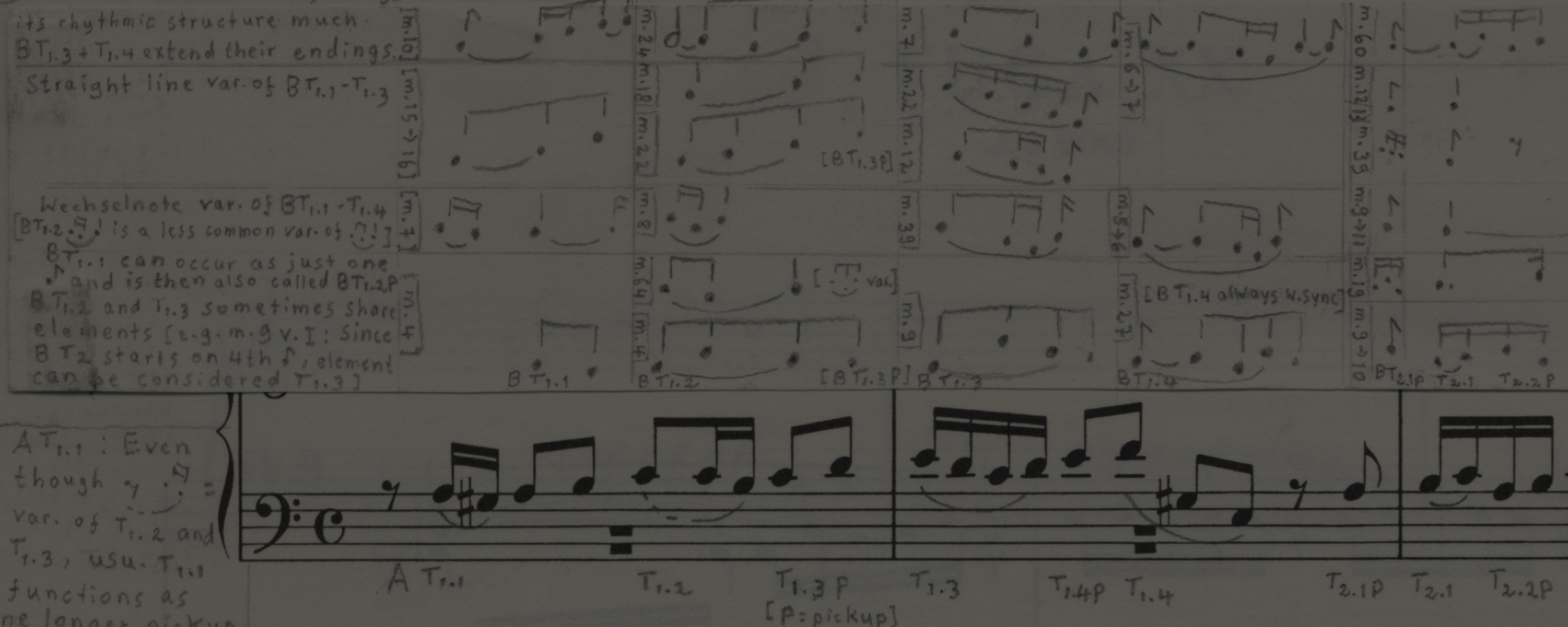
It is done: score and recordings of J.S. Bach’s the Well-Tempered Clavier Book 1 as prepared by MuseScore team and played by the pianist Kimiko Ishizaka are now released into public domain.
The Open Well-Tempered Clavier (OpenWTC) project was launched in late 2013 as a successful Kickstarter campaign, with 904 backers who pledged $44,083 of $30,000 goal. The fundraiser was boosted by 12 promotional concerts that Kimiko played in USA and Europe throughout November 2013.
OpenWTC follows another successful community-funded project, Open Golberg, where the same team prepared and released Bach’s Golberg Variations into public domain — both the score and the recordings.
It all takes time: working on performance, picking the right instrument, recording in the studio, post-processing, typesetting the score etc. And doing that for all of WTC Book 1 is no minor achievement. The outcome is the 48 Preludes and Fugues in public domain:
- audio in MP3 and FLAC (click ‘Buy’, then insert at least a zero);
- sheet music in PDF, MusicXML etc.
If you are a MuseScore user, you can also load the score directly into the application. ## What’s Well-Tempered Clavier and why it matters? Among classical music connoisseurs, the Well-Tempered Clavier Book 1 (WTC, or “the 48” for short) is widely regarded as one of the most influential works by J.S. Bach. Here is why.
For a long time instruments used to be tuned in such intervals between notes that transposition (playing a melody in a key different from the originally intended one) usually produced a melody that was clearly out of tune. Finding the right intervals was an interesting mathematical problem to solve, and it was done in the 17th century by Andreas Werckmeister.
So while J.S. Bach didn’t invent well-tempered tuning, the 48 was his major, if not defining contribution to making it popular, as the 48 was pretty much The Music Theory Bible for generations of composers.
Today we have the privilege of sneering at the (now) classical tuning and going to microtonality, because we have this solid foundation on which music as we know it is built. For instance, the kind of progression you find in Prelude in C major (BWV 846) had been cool long before Klaus Schulze et al. turned up in late 1960s and made it the flesh and bone of electronic music.
Historical value aside, the 48 is simply beautiful and elegantly sophisticated music (with score laid out in up to four voices, yet played by a single musician). If this is the first time you are listening to WTC, I officially envy you, because are about to discover something very special.
Since this clearly can’t be left at that (clearly!), LGW spoke about both the musical and the tech sides of this adventure to Kimiko Ishizaka-Douglass and Robert Douglass (team Ishizaka), as well as to Thomas Bonte and Olivier Miquel (team MuseScore).
The music
Kimiko, your rendition of Well-Tempered Clavier has some distinctive features like comparatively slower tempo in a number of pieces, and more dynamics variation compared to what Gould, Richter, Pollini, and others did in the past. To me, the overall impression is that your performance of WTC sounds more intimate. How did it come to that? :)
Kimiko: I wrote my liner notes for the CD booklet, but here are some more ideas. And by the way, not all of my tempos are slower! The A-Major Fugue, for example, is the fastest rendition I know.

The most important part of my performance is the organization, through articulation, of the thematic materials, and the emotional meaning.
All of the dynamics and the tempi derive from those goals, which might mean that there are fewer extremely fast or extremely slow tempi, and I don’t push the piano into fortissimo thunder that you might expect in a piece by Liszt.
I tried to make the music sound clear, and natural, and to show all of the incredibly brilliant connections that Bach made. I do use the dynamic range of the piano; I’m not trying to imitate a harpsichord.
Furthermore, it was very important to me that the music is contrapuntal, meaning composed of different independent voices.
Later, music evolved to consist of more chords and melodies, but in Bach’s music, especially the fugues, there is always a definite and clear sense of a number of independent voices each telling their own story. That means that each voice has its own articulation, phrasing, and dynamics.
You can see some of the thinking that went into this here:
Kimiko, how have these successful community-funded projects, Open Goldberg and Open Well-Tempered Clavier, affected your perception of performing and recording classical music? How much has changed for you in terms of interaction with your audience?
Kimiko: The two most successful aspects of these projects have been the amazing direct connection that has been built with my audience and supporters, and the high level of control over the recording process that I enjoyed.
I’ve been astounded over the past years by all of the positive feedback and support that I’ve received from people who really care about what we’re doing. Here is an example from an email that I received just today:
The effort of your team is so highly appreciated. You’re doing priceless work for mankind. I lack words. JSB would be proud! Thank you for all the tears of joy!
When I read that and the hundreds of similar messages that people have sent to us since 2012, I am very happy, and it gives me strength to continue. It means that no matter what crises may exist in the (classical) music industry, as long as performers and audiences can connect, it will all work out.
This recording of the Well-Tempered Clavier builds on my experience recording the Goldberg Variations, and it is a more perfect representation of what I want to achieve.
The advantage of running these projects the way we do is that we have complete control over all of the elements. We re-evaluated our choice of studio, and after a long search, decided to again go to Teldex.
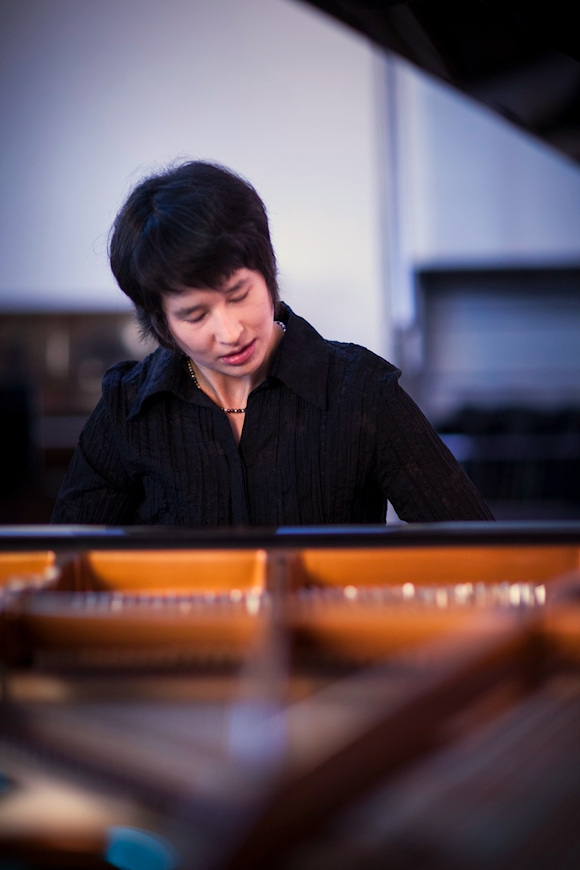
I was able to go to Vienna and play this Bösendorfer 280 before it got shipped to Berlin for the recording.
I was able to invite Anne-Marie Sylvestre to come to Germany as the recording engineer, and we were able to go for a very specific recorded sound that I am very happy with.
All of these choices were mine to make as a result of the support from our fans.
Throughout the project, you worked with a lot of people to whom the idea of community-funded recordings was likely to be novel. I mean both PARMA Recordings, Teldex Studio, and others, not to mention the audience at 12 concerts you did to promote the campaign. Did you find it difficult to get the message through?
Kimiko: The PARMA team has been great. They were attracted to the idea from the beginning (in stark contrast to some other labels who wouldn’t touch the project), and they were also the most professional in terms of coming up with a marketing plan, holding an extra round of legal review (just to make sure they understood the ramifications of a public domain recording), and in setting up worldwide distribution through Naxos.
The Teldex team is likewise very comfortable with the model, but for them, their main interest is in creating a magnificent environment in which a pianist can make and record music.
Robert: One thing that was difficult to convey in the campaign phase was the stretch goals we set involving making 50,000+ Braille scores out of the MuseScore.com digital library.
I think that for many people it’s hard to imagine how necessary it is to be able to read scores to properly play classical music.
It’s likewise hard for a sighted person to imagine what it’s like being blind, and it’s near incomprehensible, then, to understand the urgency that is felt by a blind musician searching for classical scores to read who finds out that basic stuff like Mozart Sonatas aren’t available in Braille, not because it’s technically impossible, but because too few sighted people have cared enough over the years to provide them. So that part of the campaign failed.
Are you going to work on bringing BWV 870—893 (Well-Tempered Clavier Book 2) to the audience next? Or would you explore something else?
Kimiko: My next project, which will be an audio-only project, will be to record the Chopin Préludes on a Pleyel piano that Chopin himself actually played.
It’s an exciting project, especially when you realize that Chopin dedicated the Préludes to Camille Pleyel, piano maker and owner of Salle Pleyel in Paris, at the time Chopin lived there.
There will be a Kickstarter campaign for this project that launches very very soon!
The tech
A year and a half ago you said: “When we release the score, it will come together with a MuseScore 2.0 beta release”. Looks like that worked. What was the most challenging part of this part of the adventure? Did you have to introduce more changes to MuseScore?
Thomas: When we branched off MuseScore 1.x and set the goals for 2.0 back in 2010, we quickly realised that the development of 2.0 would take a long time. As MuseScore is developed by a distributed team, working from home, we needed a concrete milestone to work for, which would in turn help us to keep up the good spirit.
Thus the idea was born of doing a Kickstarter and typeset a challenging piano piece. When sharing the idea with Robert and Kimiko, the synergy became clear rather quickly. As Kimiko was studying the Goldberg Variations at the time, Bach was the chosen one to be freed from copyright.
While the first Kickstarter was successfully finished at the beginning of 2013, the development of MuseScore 2.0 was far from over. Major parts in the code still needed to be refactored, partly because the MuseScore codebase needed to be prepared for mobile platforms. And thus by the end of 2013 we sat together again for a follow up Kickstarter, this time Bach’s Well Tempered Clavier.
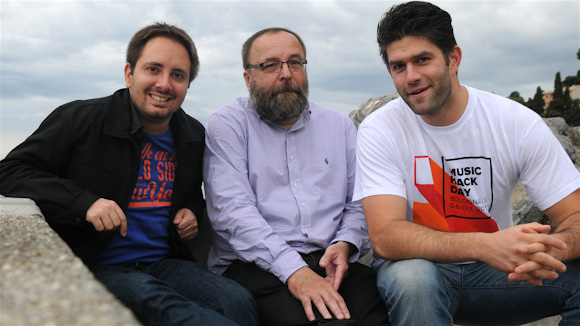
So from our side (MuseScore), the Kickstarter projects were very fun and rewarding, but all by all not that challenging. Instead, the real challenge was bringing the development of MuseScore 2.0 to a good ending.
First, many refactoring cycles took place, introducing several file format changes to extend MuseScore’s feature set. Secondly the code base needed to be prepared for mobile platforms. So there was a real risk that we would dig ourselves into a deep rabbit hole.
MuseScore users liked the 1.x series because it was easy to use, yet powerful. But would 2.0 still live up to this?
Luckily we received continuous reassuring feedback from our contributor community, but it wasn’t until outsider testimonies on the beta release started to come in that we knew that we nailed it. I’m really proud on this achievement even if it has taken us nearly 5 years. It is a giant leap forward for MuseScore.

Did Olivier Miquel work with Kimiko, when he started using MuseScore 2.0 beta to typeset the score?
Robert: Kimiko was not very involved with this score, mostly due to her extreme focus on preparing for new performing projects. The editorial decisions are solely in Olivier’s hands, with feedback from the public reviews.
Olivier: My main purpose was to give to the pianists and harpsichordists a clear, light, easy-to-read score, because Bach’s music looks often difficult enough.
Using Musescore 2.0 for a good modern editing, I relied on the contemporary practice concerning the notation. I followed two historical manuscripts, the Agricola’s (Berlin) and the Dresden’s, and compared some edited versions. It is important to know there is not one definitive and indubitable copy of Bach’s hand available.
Many well-known editions in the 19th and 20th centuries contain a lot of arbitrary signs for a piano performance. Sometimes there are important differences between the sources themselves and the main editions. The Bach Gesellschaft Edition indicates no less than 35 pages of alternative possibilities. A compromise had to be made.
How successful was community’s collaboration on proofreading the first version of the OpenWTC score?
Thomas: For the OpenWTC edition, more than 100 annotations came in from 6 reviewers. Not as much as with the review of the Goldberg Variations, but back then we advertised it better among musicologists.
In any case, we believe that the traditional publishing process for paper distribution where you have a thorough Q&A process taking place before the print production, can be challenged in the era of digital distribution.
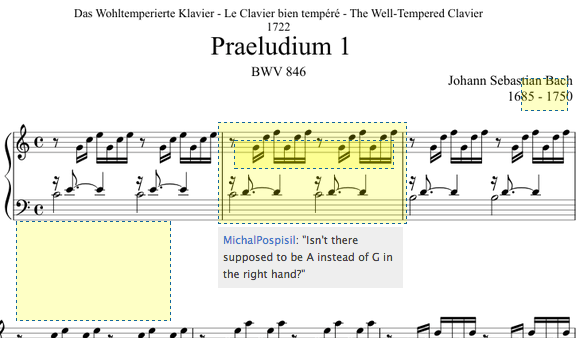
Just like users can continuously help to correct Google Maps, why not have the same solution in place for sheet music where users make corrections right in an app displaying the score? It will take some time though, but we’ll get there eventually.
Apparently at some point in the past the OpenGolberg apps was removed from iTunes, and seems to never have been released for Android. What’s the story here, and is making apps for each project like OpenGoldberg and OpenWTC something you want to do in the future?
Thomas: In parallel to the creation of the OGV edition, we were also trying to port the MuseScore codevbase to mobile platforms. In a first phase, this simply meant rendering a MuseScore file on an iPad as it was the dominant tablet back then. Developing for Android wasn’t an option anyways, since the SDK was not ready for our requirements.
We managed to create a prototype app using the Goldbergs just a few weeks before the Kickstarter release date. Even though it was not part of the Kickstarter goals, we thought it would be a great surprise to deliver a dedicated OGV application, free for both backers and non-backers.
We hired a designer, pushed some late nighters and managed to get the app submitted for the Apple App store a week before the release. Unfortunately we missed to set a flag in the code and the software was rejected. A real bummer given that we missed the opportunity leverage the great exposure in press to push Bach all the way up in the app store ranking. A week later the application was released.
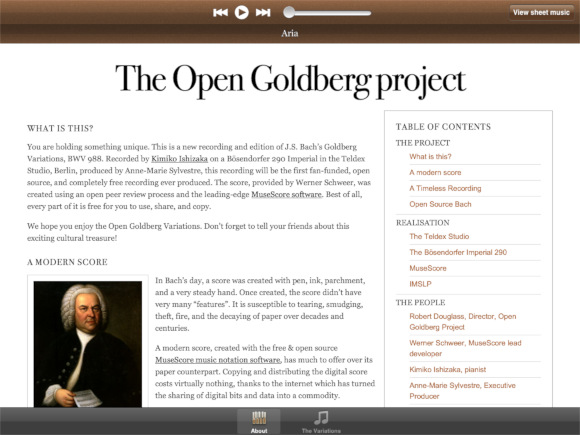
We wondered if there was an opportunity to create a dedicated app for the great classical works — the app as a sort of digital replacement for the album. But we figured this would go away from what we really wanted to achieve which is lowering the barrier to learn to play your favorite songs.
And as focus is important, we halted further development of dedicated apps for the Kickstarter projects. This also meant that when the OGV stopped working on iOS 8, we had to remove it from the app store. All focus has been going to the MuseScore application since then.
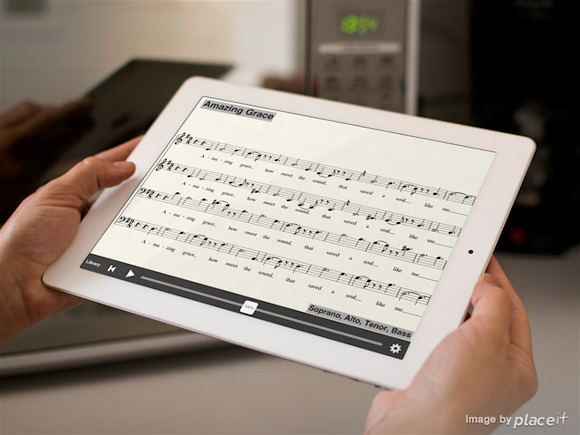
You didn’t reach stretch goal to make Braille version of OpenWTC available. But in 2014, you did release Open Goldberg in Braille anyway thanks to RNIB’s involvement. Could you tell a bit about your collaboration with that institute? What’s the plan for OpenWTC?
Thomas: In the spring of 2013, we were approached by the people at the Royal Institute for the Blind based in London. RNIB helps visually impaired and blind musicians to obtain sheet music in the way they can read it, as a large print version or as a Braille score. To offer this service, RNIB in turn relies on hundreds of volunteers who use very expensive and proprietary notation software to transcribe music and create these special editions.
They wondered if MuseScore could help to make this process simpler and less expensive. As MuseScore is all about making music more accessible, we didn’t think twice to take on this challenge. Yet, quite some development was needed.
The first project revolved around implementing RNIB’s own invented standard named Modified Stave Notation into MuseScore, which is basically a set of engraving rules to create large print music which is easier to read by visually impaired musicians.
In a follow up project, the focus was on making MuseScore more accessible by making it work with the NVDA screen reader so that MuseScore could verbally read the music to you while navigating through the score.
So today with the Open Well-Tempered Clavier edition freely available for everyone, visually impaired musicians can open it in MuseScore 2.0, apply an MSN style to it, and create their own large print edition. Blind musicians can let MuseScore verbally read the score, or read the Well-Tempered Clavier through their braille terminals.
I’m demonstrating these innovations to the public for the first time at the UKAAF conference on March 20th in London.